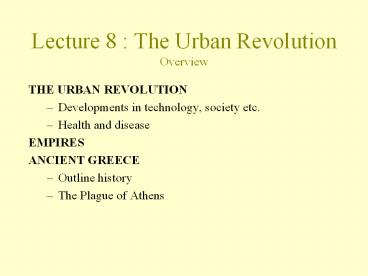Lecture 8 : The Urban Revolution Overview - PowerPoint PPT Presentation
1 / 20
Title:
Lecture 8 : The Urban Revolution Overview
Description:
Lecture 8 : The Urban Revolution Overview THE URBAN REVOLUTION Developments in technology, society etc. Health and disease EMPIRES ANCIENT GREECE Outline history – PowerPoint PPT presentation
Number of Views:183
Avg rating:3.0/5.0
Title: Lecture 8 : The Urban Revolution Overview
1
Lecture 8 The Urban RevolutionOverview
- THE URBAN REVOLUTION
- Developments in technology, society etc.
- Health and disease
- EMPIRES
- ANCIENT GREECE
- Outline history
- The Plague of Athens
2
The Urban Revolution
- Technology - wheel, plough, fertiliser,
irrigation. - Food surplus division of labour (craftsmen,
traders). - Towns and cities.
- Stratified class system administrative/military
elite. - Religion and science (writing, mathematics,
astronomy). - Arts and culture.
- Farmers converted to peasants.
3
The First Civilisations
- The earliest was Mesopotamia in modern Iraq.
- Egypt and the Indus valley civilisations followed
soon after. - Northern China (Huang-Ho) around 2,000BC.
- Meso-America and Peru first milllennium AD.
4
(No Transcript)
5
(No Transcript)
6
(No Transcript)
7
(No Transcript)
8
(No Transcript)
9
(No Transcript)
10
Health And Disease
- The urban revolution resulted in a further
decline in health and life expectancy. Factors
included - Diet further deficiencies.
- Airborne diseases increased due to crowding.
- Water-borne diseases increased due to
contamination by sewerage. - Irrigation also created new risks.
- Food-borne infections increased due food
storage and handling. - Vector-borne infections increased due to
increase in rodents, birds and arthropods. - Direct contact more opportunity for sexual
transmission.
11
Epidemics And Endemics
- Susceptibility to devastating epidemics due to
absence of previous exposure. - Increased populations enabled some diseases to
become endemic. - Adaptation between agent and host meant some
diseases became relatively mild diseases of
childhood. - This conferred a military advantage on urban
armies which carried immunity.
12
Demographics
- Despite developing immunity against certain
diseases, cities became much more unhealthy than
rural areas. - Death rates in cities exceed birth rates.
- Cities became dependent upon the migration of
surplus rural people to maintain numbers. - This continued throughout history cities only
became self-supporting around the beginning of
the 20th century.
13
Empires
- Some city states developed into extensive
empires, which came and went. - The change in scale does not appear to have had
any major implications for the history of disease.
14
(No Transcript)
15
(No Transcript)
16
(No Transcript)
17
(No Transcript)
18
Ancient Greece
- In Europe urban civilisation first made its
appearance in Greece, initially in Crete and then
on the mainland. - Athens and Sparta emerged as the most influential
city states between the 8th and 6th centuries BC,
but Greece was never politically unified. - Athens led the resistance against the Persians in
the 5th century BC and might have formed the
focus for a unified Greece. - Athens lost the Peloponnesian War against Sparta
in 431-404 BC, after being devasted by a plague
in 430-429 BC.
19
(No Transcript)
20
Thucydides
- No healing art was of any use, nor were
prayers, consultations of the oracles or anything
else. Men in perfect health were seized in a
moment with violent fever, inflammation of the
eyes, sore throat and tongue. The breath was
foetid, there was coughing and vomiting, violent
convulsions, livid skin breaking out in pustules
and ulcers. The internal fever was intense so
that the sufferers could not bear to wear even
the finest linen garments, but insisted on going
naked. They longed for cold water many threw
themselves into the cisterns. There was an
intolerable restlessness which never left them.
Either they died on the seventh or ninth day or,
if they lived, the disease descended into their
bowels where it produced violent ulceration,
severe diarrhoea, and later exhaustion that
carried them off. The fury with which it fastened
on each sufferer was too much for human nature to
endure.































